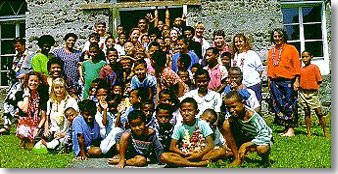 Sawaieke
Village, on the isolated island of Gau, is a special place.
The chief of Gau (the "Takalaigau") first invited
NAI'A's passengers to visit ashore in 1994, and the village
visit near the end of the charter has become one of the
highlights, even for people who came to Fiji intent only
on diving as much as humanly possible. The reason: Fijians
are the friendliest people on earth and a visit to Sawaieke
is like being invited home by a new friend -- multiplied
by the 150 or so villagers who normally turn out to welcome
us. They are honored that we have chosen to visit their
village, where there is no hint of commercialization,
and they are somewhat in awe that we would travel all
the way from across the world to dive on their reefs.
Most of the passengers who return for their second or
third visit come back in part to go back to see their
friends at Sawaieke.
Sawaieke
Village, on the isolated island of Gau, is a special place.
The chief of Gau (the "Takalaigau") first invited
NAI'A's passengers to visit ashore in 1994, and the village
visit near the end of the charter has become one of the
highlights, even for people who came to Fiji intent only
on diving as much as humanly possible. The reason: Fijians
are the friendliest people on earth and a visit to Sawaieke
is like being invited home by a new friend -- multiplied
by the 150 or so villagers who normally turn out to welcome
us. They are honored that we have chosen to visit their
village, where there is no hint of commercialization,
and they are somewhat in awe that we would travel all
the way from across the world to dive on their reefs.
Most of the passengers who return for their second or
third visit come back in part to go back to see their
friends at Sawaieke.
Before we go ashore, I give a "village briefing" that explains what to expect and what not to do. Don't wear a hat or sunglasses, don't pat the kids on the head (this is almost impossible to resist: they're so cute!), don't point your feet at the yaqona bowl or at the chief, and be sure to wear shorts under your sulu in case if falls off. Among the complementary gifts you'll find in your stateroom when you arrive is a sulu, which is mandatory for the village and awfully comfortable the rest of the time, too. Wearing it to dinner a few nights before the village visit helps ensure that you learn how to tie it successfully....
The visit includes a stroll through the village before we gather in the large meeting hall. The villagers love to have their pictures taken, and every time I go ashore I bring copies of photos that passengers from a previous visit have sent back. In the meeting hall our spokesman, Rusi, offers our sevu-sevu, a one-kilo bundle of yaqona. The village spokesman receives the sevu-sevu with appropriate gravity, and offers one in return, which Rusi accepts. Now that we are officially accepted as wards of the village for the duration of our stay, we get to drink yaqona in earnest. People claim that yaqona tastes like dirty dishwater, but if they know what dirty dishwater tastes like clearly their judgment is suspect. I like yaqona. And Sawaieke mixes a good batch. Mildly narcotic (according to US Customs agents), yaqona is made from the pounded roots of a pepper plant. Good stuff is at least three years old, fine quality is six years old, and the twelve year old stash is saved for special occasions. We usually go several bowls, each individually served from a half-coconut shell ("bilo"). Meanwhile the village children, or the old women, or sometimes the young men put on a meke: a traditional song and dance which tells a bit of the history of the place. Two hours - - and five bowls of yaqona -- is about right for newcomers to Fijian village life, so to the strains of Isa Lei, the Fijian farewell song, we file out of the hall to return to NAI'A. After five bowls of yaqona most people are glad that NAI'A has nine separate passenger toilets....
